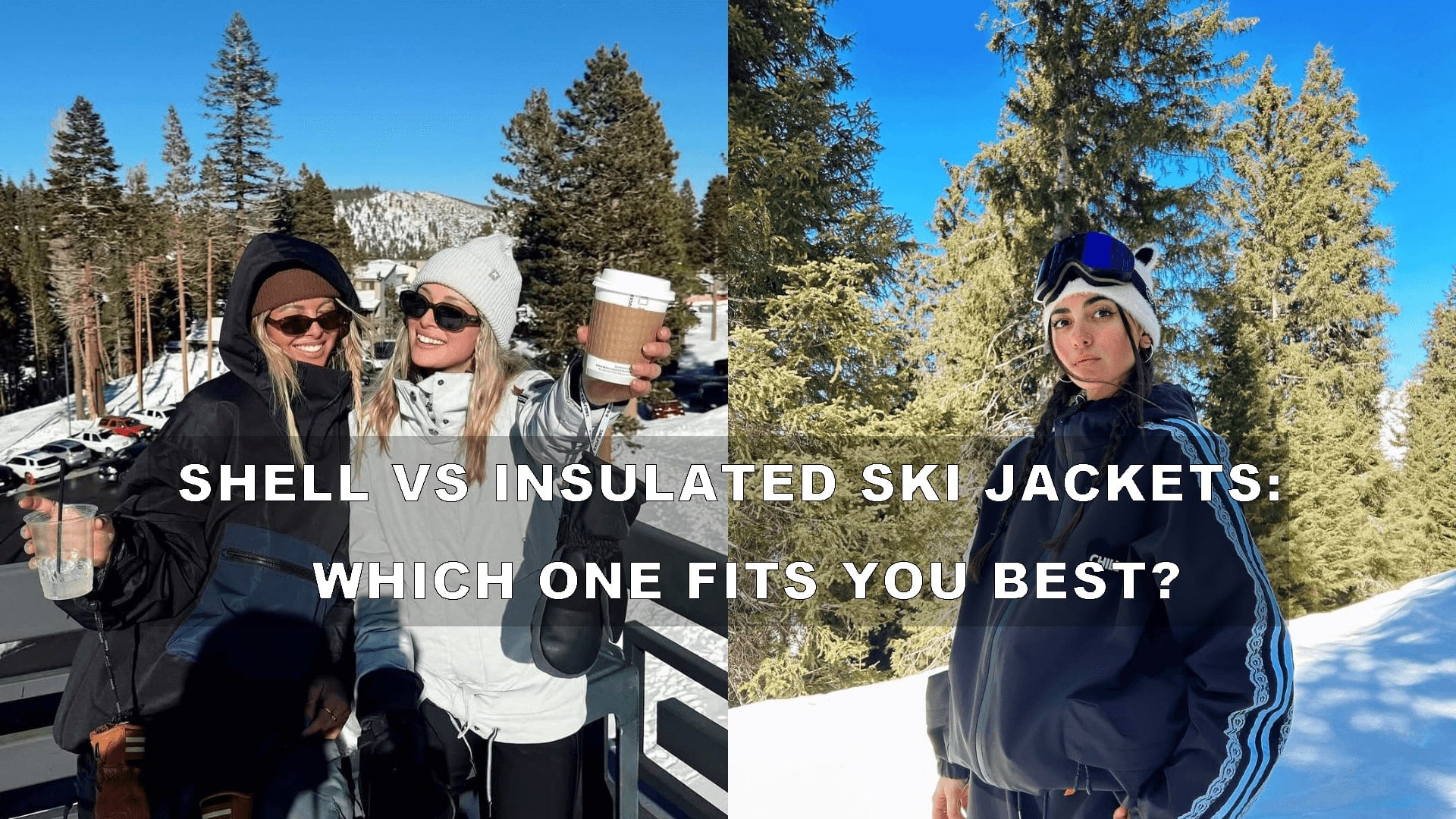
Introduction
Choosing the right ski jacket is essential for a fun and safe day on the slopes. It acts as your shield against the elements—keeping you warm, dry, and free to move. The perfect jacket can elevate your skiing experience, while the wrong one can quickly turn your day cold and uncomfortable.
But don’t worry—we’re here to help.
In this blog, you’ll learn:
The key differences between insulated and shell ski jackets
How to choose the best option for your needs and skiing style
By the end, you'll be equipped to pick the perfect jacket that offers comfort, protection, and performance—so you can hit the slopes with confidence.
Table of Content
Ski Jackets: Shell vs. Insulated
1.What Are Insulated Ski Jackets?
Insulated ski jackets come with built-in padding—typically made from down or synthetic fibers—that traps your body heat and keeps the cold out. These jackets are specifically designed to provide warmth on the slopes, making them an ideal choice for cold-weather skiing.
With an insulated jacket, you can stay cozy and comfortable even in freezing temperatures. They’re perfect for chilly days when you need that extra warmth to fully enjoy your skiing adventure.
2.What Are Shell Ski Jackets?
Shell ski jackets act as a weatherproof outer layer that shields you from wind, rain, and snow. Unlike insulated jackets, they don’t contain built-in padding. Instead, their main job is to keep you dry and block harsh weather conditions.
Because they lack insulation, shell jackets offer flexibility—you can add or remove base and mid-layers underneath depending on the weather. This makes them highly versatile, especially for skiers who face a wide range of conditions on the mountain.
Men's Ski Jackets For Beginners
Insulated Ski Jackets – Key Features
Warmth: Filled with down or synthetic insulation to trap heat
Comfort: Great for cold conditions, retains body warmth effectively
Convenience: Acts as a single, all-in-one warm layer—no heavy layering needed
Shell Ski Jackets – Key Features
Lightweight: Non-insulated design allows for greater mobility
Versatile: Layer underneath based on the weather and activity level
Protection: Excellent wind and water resistance for changing conditions
Materials and Construction of Ski Jackets: Shell vs. Insulated
Understanding the materials and construction behind ski jackets can help you make a more informed choice. Shell and insulated jackets use different fabrics and designs to serve distinct purposes.
Insulated Ski Jackets
Outer Material: Typically made from durable, water-resistant fabrics like nylon or polyester, often treated with DWR (Durable Water Repellent) coating
Insulation Layer: Filled with either down (natural insulation, lightweight but less effective when wet) or synthetic fibers (such as PrimaLoft, which stays warm even when damp)
Lining: Soft inner lining for added comfort and moisture-wicking
Construction Purpose: Built for warmth and comfort , often bulkier but convenient for cold conditions
Shell Ski Jackets
Outer Material: High-performance waterproof and windproof fabrics like GORE-TEX , eVent, or proprietary membranes (e.g., Omni-Tech)
No Insulation: Designed as a protective barrier rather than a warming layer
Seam Sealing & Ventilation: Often fully seam-sealed with pit zips or ventilation panels to help regulate temperature
Construction Purpose: Built for versatility and layering , offering freedom of movement and adaptable protection
Women's Ski Jackets For Beginners
💡 Learn More About the Advanced Materials in Ski Jackets
When it comes to performance on the slopes, the materials used in ski jackets make a huge difference. Here are some of the leading fabric technologies that power today’s top shell and insulated ski jackets:
GORE-TEX® (USA)
A global leader in durable, waterproof-breathable technology, GORE‑TEX is widely used in jackets, pants, gloves, and more. Known for its unmatched performance in extreme conditions, it now features the innovative ePE (expanded polyethylene) membrane —a lighter, more sustainable material that maintains high durability and water resistance. It’s a game-changer for eco-conscious skiers seeking top-tier gear built to last.
eVent® Fabrics (USA)
eVent jackets are designed with bio-based membranes and PFAS-free DWR coatings , offering both high performance and environmental responsibility. eVent’s Direct Venting™ technology allows sweat to escape instantly, making it a top choice for active skiers and mountaineers.
Polartec® (USA)
Known for its innovation across base, mid, and outer layers, Polartec fabrics are engineered with scientific precision. From insulation to fleece and weather protection layers, Polartec materials are soft, breathable, and reliable—crafted to perform under tough conditions while offering superior comfort.
Dermizax™ (Japan)
Developed by Toray, Dermizax™ is a dynamic waterproof and breathable membrane system available in three variations:
Dermizax™ Original: Balanced waterproofing and breathability for everyday skiing
Dermizax™ EV: Enhanced breathability for high-output activities like ski touring
Dermizax™ NX: Premium protection with excellent moisture release for extreme weather
Its customizable yarn design allows brands to tailor fabric performance for specific sports.
Sympatex® (Germany)
Sympatex membranes are made with recyclable, PFAS-free polyester and are bonded to a variety of outer fabrics. Known for their eco-friendly construction , these membranes are windproof, waterproof, and breathable—making them a solid choice for sustainable outerwear.
Conclusion
Insulated and shell ski jackets serve different purposes and come at varying price points. From my personal experience, it’s wise to have both types in your gear collection. This way, you can easily adapt to different weather conditions—staying warm and protected without the bulk of extra layers.
Insulated Jackets: Ideal for cold, consistent weather, providing built-in warmth and comfort without the need for layering.
Shell Jackets: Offer flexibility and breathability, allowing you to adjust warmth with layers, perfect for varying weather conditions.
Material Technologies: Advanced materials like GORE-TEX®, eVent®, and Polartec® enhance performance, durability, and sustainability in both jacket types.



















